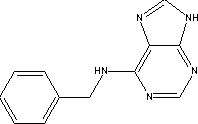Product show
6-Benzylaminopurine (6-BA)
Identification
Synonyms: 6-benzyladenine (IUPAC); 6-BAP; 6-BA; BAP; N6-benzyladenine
CAS No.: 1214-39-7
Molecular Weight: 225.25
Molecular Formula: C12H11N5
Structural Formula: 
Form: Colourless, odourless, fine needles; (tech. is an off-white powder).
M.p.: 232.4 °C
B.p.: 306.2 °C/1330 Pa
V.p.: <1.48 × 10-1 mPa (20 °C)
S.g: 1.374 (20 °C)
Solubility: In water 62.2 mg/l (20 °C). In methanol 6.71, ethyl acetate 0.722, n-hexane <0.01, acetone 1.39, toluene 0.0214, dichloromethane 0.251 (all in g/l, 20 °C).
Stability: Stable in acidic, alkaline and neutral aqueous solution; hydrolysis DT50 >1 y (pH 4, 7 and 9, 25 °C). Aqueous photolysis DT50 2.5 d in natural water, 12.8 d in distilled water (both 25 °C, 400 W/m2, 300–800 nm). Stable to heat at 150 °C; decomposes at 400 °C.
Application
6-Benzylaminopurine (6-BA) stimulates RNA, RuDP-carboxylase, NADP-glyceraldehyde-3-phosphate-dehydrogenase, protein synthesis. Mode of action Synthetic cytokinin; little translocated. Used to stimulate the following effects: cell division; lateral bud emergence (apples, pears, oranges); basal shoot formation (roses, orchids); flowering (cyclamen, cacti); fruit set (grapes, oranges, melons); causes abscission of young fruitlets, leading to increased fruit size, stimulates flower bud formation and regular bearing in fruit trees. Inhibits senescence of rice seedlings. Enhances lateral bud break and lateral shoot growth, leading to fuller white pine trees. Also causes uniform bolting and increased seed production in spinach. Applied by foliar application, soaking, or painting. Its limited ability to translocate is utilised to restrict effects to the target part of the plant, by local application. Applied at 30 g/a for apple trees.
Specification*
| 6-Benzylaminopurine (6-BA) Content | 99% min. |
|---|---|
| m.p. | 230-233°C |
| Residues after ignition | 0.1% max. |
| Loss on drying | 0.5% max. |
Standard Packaging
0.5kg, 1kg, 2kg/aluminum foil bag, 25kg/carton, 25kg/fiber drum
Risks and Safety Information
6-Benzylaminopurine (6-BA) is not regulated by UN as hazardous substance.
Acute oral LD50(male rats) 2125, (female rats) 2130. Skin and eye Acute percutaneous LD50(rats) >5000mg/kg. Not a skin or eye irritant (rabbits). Not a skin sensitiser. Birds LD50 (14d for northern bobwhite quail) >2250 mg/kg. Fish LC50 (96h for carp) 38.5mg/l. Algae EC50 (72h for Selenastrum capricornutum) 48.7mg/l. Bees LD50 (oral) 400μg/bee, (contact) 57.8 l/ha (both ‘Paturyl’ 10 SL formulation). LD50 (oral) >100μg a.i./bee.
